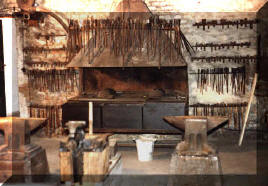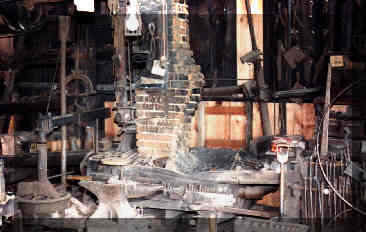 Alte
Schmiede - Otto Schmirler's old shop in Vienna,
Austria 1991. Angle iron and steel plate for ornamental ironwork.
Alte
Schmiede - Otto Schmirler's old shop in Vienna,
Austria 1991. Angle iron and steel plate for ornamental ironwork.[Home] [Back To The Forge & Fire] [The Coal Forge 1] [The Coal Forge 2] [The Coal Forge 3]
Updated September 16th, 2019.
March 21st, 2000. Showcasing forges used for professional blacksmith and locksmith work. Here are 5 pages of photos of coal forges in use by shops which build ornamental gates and railings, build and repair agricultural tools and machinery, and forges which produced historical reproductions of implements and ironwork used long ago. A short text will accompany each picture describing the work of that shop as well as specific details of each photo. This is the first in a series of 3 jump pages linking to my documentary on the blacksmith's coal forge. More pages are found in the navigation bar at the top of this page.
 Alte
Schmiede - Otto Schmirler's old shop in Vienna,
Austria 1991. Angle iron and steel plate for ornamental ironwork.
Alte
Schmiede - Otto Schmirler's old shop in Vienna,
Austria 1991. Angle iron and steel plate for ornamental ironwork.
Built in the 500 year old vaulted ceiling ground floor of a building near the heart of old Vienna, just a short walk from St. Stevens Cathedral. This is the shop of the late Otto Schmirler who is the author of some of the finest books on the art of ornamental blacksmith (locksmith) in the world. Established originally around 1880 and finally closing its doors about 1980. Today the shop is a museum still hosting blacksmithing demonstrations by the best ornamental blacksmiths in Europe. Four steel forges (a pair of double forges) occupy this workshop. The photo at left shows one of these double forges. Click on the picture or the link here and above to see; Alte Schmiede. http://www.beautifuliron.com/cf_Vienna.htm
Gmünd,
Austria 1991. Steel pipe and steel plate for ornamental ironwork.
Built into the side of the medieval wall surrounding the old village of Gmünd, Austria, is an modern Locksmith or ornamental ironworking shop. These master smiths produce much of the beautiful ironwork used in the buildings of the area. The blacksmith works in dimly lit shops so to be able to see the color of his iron more clearly. In this shop are made gates, grills, railings, sign brackets and lanterns, and small iron objects. We photographed this shop during the Christmas season while walking through the village of Gmünd, Austria. Everywhere the shops were lit up with colored lights. Nearly every shop in town had some kind of beautiful ironwork adorning the building - sign brackets, window grills, light fixtures, gates, railings - and it appears that a large part of that ironwork was made right here in this blacksmith shop. There are several forges in this blacksmith's shop, but this page is focused on only one of the large double forges. Click on the picture or link here and above to view more photos of Gmünd Locksmith. http://www.beautifuliron.com/cf_Gmund.htm
Anderson
Blacksmith Shop, Colonial Williamsburg,
Virginia, USA 1992. Masonry for tool and hardware making.
Colonial Williamsburg in Williamsburg Virginia, is a very large open air living history museum. Anderson's blacksmith shop at Colonial Williamsburg is a historical reconstruction of a colonial era blacksmith shop built nearby during the revolutionary war. The reconstruction demonstrates methods of colonial era building construction ( long since disappeared ) and creates the setting for historical interpretation of the type of work done by blacksmiths during the colonial era. James Anderson opened his original shop in the 1760's, making and repairing iron implements for private customers and became Public Armorer for the state of Virginia. Click on the picture or link here and above to view more of Anderson Blacksmith. http://www.beautifuliron.com/cf_Anderson.htm
 Quasdorf
Wagon & Blacksmith, Dows,
IA. USA 1996. Early 1900s style Masonry blacksmiths forge.
Quasdorf
Wagon & Blacksmith, Dows,
IA. USA 1996. Early 1900s style Masonry blacksmiths forge.
Quasdorf Blacksmith Wagon Museum. A typical masonry forge popular in rural blacksmith's shops in the early part of this century. The blacksmith in this shop built wagons as a large part of his business early this century. He also shod the horses and made and repaired iron and steel tools and implements. The design of this forge made it very comfortable to use. The shop is spacious and open, and an abundance of old types of tools and machinery make it obvious that this shop continued to repair the older style agricultural implements until quite recently. The last owner passed away in the early 1990's, and the shop is now a museum and historical landmark open to the public. Click on the picture or link her and above to view more of Quasdorf Blacksmith in Dows Iowa. http://www.beautifuliron.com/cf_QuasdorfDows.htm
 Matthew
Edel Blacksmith, Haverhill
IA, USA 1991. Wood and masonry blacksmith's Forge.
Matthew
Edel Blacksmith, Haverhill
IA, USA 1991. Wood and masonry blacksmith's Forge.
The Matthew Edel Blacksmith Shop made and repaired farming tools and implements, repaired and built wagons, and shod horses. The forge made of wood and brick with a cinder bed, stands as testimonial to the use of wood as one of the materials used in building a forge. This shop was quite literally a time capsule which stood unopened from the time the blacksmith passed away in the 1940's until the State Historical Society reopened the shop as a museum in the early 1980's. Click on the picture of the link here and above to view more of Matthew Edel - Haverhill Blacksmith http://www.beautifuliron.com/cf_Haverhill.htm
Page updated October 16th, 2010.
I stopped here to keep load time fast. To see more forges, click here: The Coal Forge II.
There are more forges on an additional page at The Coal Forge III.
The author can be emailed at address in picture below:
Original completion date March 21st, 2000.